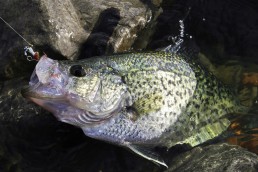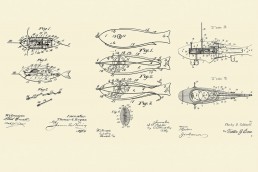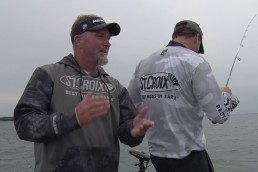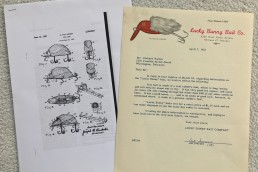Casting Crappie Lures from the Bank
SHARE THIS POST
During my years as a guide on Kentucky Lake, I proved to myself and others that one can actually catch more crappies with artificial lures than with bait. In fact, I gave away all my minnow buckets and opted for molding my own horsehead jigs because while experimenting extensively with all manner of artificial baits, I came to the conclusion that nothing casted out and retrieved caught crappies better than Road Runners.
So, when I found myself among the bank-bound ranks some years ago, I started applying what I had learned from a fast boat and toward the more pedestrian approach of a shoreline angle. Some adaptations, though, were necessary. To catch as many or more crappies from a bank with artificials, I had to change some things and adopt some methods that worked better from a bank than from a boat.
The two biggest problems facing bank-bound crappie anglers are finding suitable cover for fish close to the bank and avoiding snags once you do find it.
I had to give up my open-hooked horsehead jigs and curly-tail grubs because I found myself losing far more to the brush than seeing ones stuck in the mouths of crappies. Instead, I started casting weedless 1/16-ounce Crappie Sliders that I could either retrieve very slowly through the tangles or be worked through this cover like a plastic worm without getting hung.
Equally, if not more productive, I had paddle bugs and tube jigs that were fished just above the brush on a slip-bobber rig. On quiet days I’d retrieve the slip-bobber rig very slowly, pausing often, but on windy days, I’d let the chop of the water impart all the action.
Finding good places to fish on the banks are a concern, and there was a time when the best fishing in old lakes like Kentucky Lake and Lake Barkley were close to shore. But over the years much of that original cover has rotted and has been replaced with all manners of brush piles and various items planted by guides and avid anglers.
Are you enjoying this post?
You can be among the first to get the latest info on where to go, what to use and how to use it!
The problem is these savvy slab slayers aren’t about to place their secret crappie magnets along the bank where any weekend angler could find them and clean them out. Instead, they place them at least a cast-length from the bank, which puts almost all of them beyond the reach of bank anglers.
There still are a few places along the banks that attract and hold spawning crappies, but I noticed all those anywhere near access areas were far from a secret as they were crowded and over-fished. I knew that most of the best spots were out of reach even though I knew where many were. It’s just that now I couldn’t get to them.
Just as I had done from a boat, I needed to find more secluded or overlooked spots along these banks that were away from the easy accesses. I studied lake maps, looking mostly for shallow stump fields, and did some walking, carrying a small, light box of lures. During that first year I found a couple of good secluded spots, but I must admit I didn’t do very well and it was a bit frustrating. Nevertheless, I’m stubborn about these things and saw it as gaining experience and going through a learning curve for bank-bound crappies. I learned years ago that those who catch the most are not fishermen who are lucky, but those who are persistent and motivated by the puzzles and challenges of fishing and how to overcome them.
What really turned this thing around was walking the banks of Kentucky Lake during the lowest water levels of the winter. That’s when I started noticing shallow stake beds, brush piles and old stump fields that during the spring crappie spawn—and later bass spawn—would be under 4 to 8 feet of additional water, yet still located close enough to reach from shore. And, I found that shallow stump fields in coves on the LBL side have been especially productive. What I learned on Kentucky Lake would then also apply to any of the larger lakes.
Finally, during these lower water levels of winter, it’s also a time when a bank-bound angler can create his own crappie hot spots by planting cover, of course wearing boots or waders. I mentioned earlier about many putting cover in heavily pressured areas, but the point is you need to improve your crappie-fishing luck from the bank and do what many guides do offshore. Find spots away from the crowds and make your own luck by attracting crappies to the secluded spots you’ve found and make habitat improvements.
MWO
SHARE THIS POST
Did you enjoy this post?
You can be among the first to get the latest info on where to go, what to use and how to use it!
Ron Kruger
Ron Kruger has been communicating the outdoor experience for more than four decades. He has worked as a full-time guide for trout on the North Fork, for crappies and bass on Kentucky Lake and for smallmouths on the Current River. He has served as editor of three outdoor magazines, and owns a patent on a fly/lure called the Desperate Diver.



